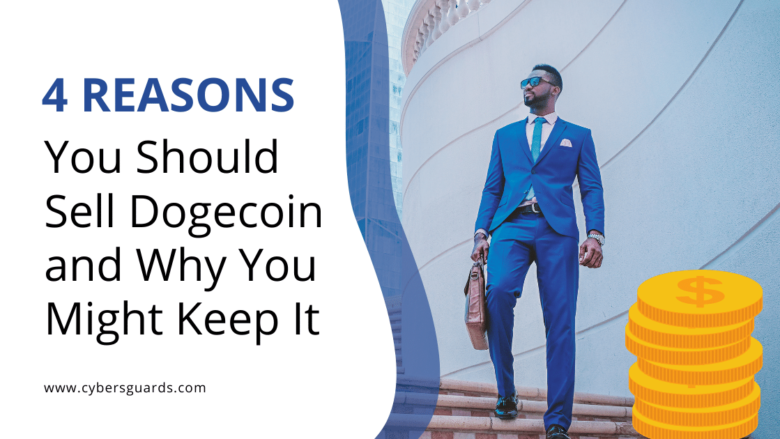Do you still have your Dogecoin? There are a few reasons why you might want to sell—and a few reasons why you might want to keep it.
Dogecoin was the most popular meme coin in 2021, with a price increase of about 216 percent in January alone. It didn’t end there, though. Dogecoin continued to rise, reaching an all-time high in April, as investors rushed to buy the coin, many of whom were motivated by Tesla CEO Elon Musk.
As the price of Dogecoin has fluctuated, many investors have wondered, “Should I sell my Dogecoin?” As a result, we’ve put together this list to assist you in making your decision.
1. You made a good profit.
To various people, a reasonable profit means different things. If you’ve doubled, tripled, or quadrupled your initial investment, that’s a solid indicator of when to sell Dogecoin. Given Dogecoin’s volatility, taking out approximately 50% of your holdings could make sense if you’ve already earned a significant profit.
You’ll have enough money to meet capital gains taxes as well as a considerable return on your initial investment if you sell out. Furthermore, all of your Dogecoin assets are pure profit. As a result, even if Dogecoin loses value, you will not lose any of your initial investment.
You can always move funds back into Dogecoin once the market has settled. However, because to the volatility of the crypto market, it’s difficult to anticipate how a coin will perform in the future, and there’s always the risk that your investment in Dogecoin or any other crypto may disappear.
2. Dogecoin Is a Risky Investment
Dogecoin is a speculative asset that fluctuates between bull and bear markets.
Dogecoin isn’t alone in its speculative nature. All cryptocurrencies are high-risk, high-reward investments. The novelty of Dogecoin contributed to its viral success, but its real-world utility remains unknown.
People often buy Dogecoin without understanding its fundamentals in the expectation of selling it for a higher price to another investor. Unfortunately, these speculative moves make the coin difficult to use as a stable store of value.
Bitcoin, on the other hand, has built social trust over time and has a first-mover advantage. Dogecoin, unlike Ethereum and Cardano, is not programmable, hence it cannot be used to create decentralized applications.
3. Dogecoin Isn’t Useful in Real Life
While Dogecoin has generated substantial gains for some of its early investors, the coin has few practical applications. Dogecoin was designed as a payment network by its creators. The token, however, has not been extensively accepted for this purpose.
According to the internet business directory Cryptwerk, just a few thousand merchants accept Dogecoin. That’s a small percentage of the millions of small enterprises in the United States.
4. Dogecoin has an infinite supply.
Dogecoin, unlike Bitcoin, has an infinite supply, making it an inflationary coin.
Bitcoin is unique due to its limited supply of only 21 million coins. Many alt-currencies have followed Bitcoin’s lead and set a hard limit on the number of coins that can be generated.
The endless supply of Dogecoin, on the other hand, makes it inflationary and ineffective as a long-term store of value. In other words, the more Dogecoins in circulation, the less valuable the coin becomes.
Why Should You Use Dogecoin?
Dogecoin is inflationary and has limited real-world applications, but the narrative does not end there. Although Dogecoin has seen minimal popularity as a payment method in the last year, that could change.
There will be no more Bitcoin to mine around 2140. Dogecoin’s supply, on the other hand, was designed to grow at a defined absolute pace, ensuring a consistent increase in supply over time. Once mined, the quantity of Dogecoins grows at a pace of roughly 5 billion each year.
While the quantity of Dogecoins can grow indefinitely, there will eventually be a practical limit. It’s easier to use as a money to buy goods and services because the coin’s growth is predictable. As a result, the prospect of widespread adoption in the future may make Dogecoin worthwhile to preserve.
There’s more. To reduce energy usage and boost transaction speeds, Dogecoin is planned to switch from proof of work (PoW) to proof of stake (PoS). Dogecoin, like Bitcoin, has depended on proof-of-work (PoW) to validate transactions until recently.
For Dogecoin owners, the move to PoS would be beneficial because it would allow everyone who owns the coin to validate transactions. They’d also get a defined percentage of the pledged assets as compensation when a new block is added to the blockchain. So, if you own Dogecoin, it could be a smart idea to hold on to it until the projected PoS switch happens.
Another consideration before selling Dogecoin or any other cryptocurrency is the potential tax consequences. Your positions equal unrealized gains or losses if you possess Dogecoin. If you sell the coin, you may be hit with a large tax charge. As a result, it’s critical to set aside funds to cover these expenses when it’s time to file.
Is it Time to Sell My Dogecoin?
When to sell Dogecoin is a personal decision based on your specific circumstances. There are various reasons to sell the meme currency, but there are also several reasons to keep it. Because of the high volatility of Dogecoin and cryptocurrencies in general, it’s advisable to invest only what you can afford to lose and to do as much research as possible before spending any money.










FIND US ON SOCIALS